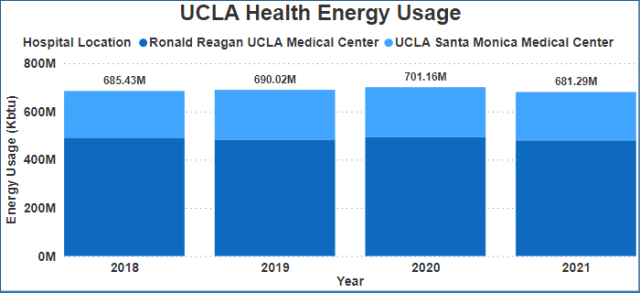Energy Conservation
Healthcare facilities and hospitals consume about 2 to 4 times more energy than a typical commercial office building. Therefore, energy reduction and efficiency are a primary focus for reducing UCLA Health’s carbon emissions, in addition to analyzing our energy sources and generation. Our goal is to reduce our EUI (energy use intensity) by 2% per year as noted in the UC Sustainable Practice Policy. Since 2020, UCLA Health as reduced its EUI 2.83%.

Energy Reduction Efforts
Our facilities team works within our operations to reduce energy through a variety of ways. The first is by replacing less energy-efficient lighting with LEDs and incorporating occupancy motion-sensors to turn off lighting when rooms aren’t in use. The facilities team works on retro commissioning projects, equipment upgrades, building automation, and other projects to reduce consumption further.
De-carbonization
De-carbonization of our energy supply and transitioning to clean, renewable fuel is the path forward for UCLA Health. Wherever possible, UCLA Health has installed photovoltaic (PV) solar panels on a few buildings and parking structures and continues to evaluate additional on-site generating opportunities.
OR Energy Reduction
Operating Rooms are three to six times more energy-intensive per square foot compared to hospitals as a whole due to more stringent requirements for ventilation and temperature control to maintain a sterile environment and the use of energy-intensive surgical and patient monitoring equipment. The energy team is performing an assessment of each OR to identify opportunities for energy reduction in compliance with regulatory and Joint Commission requirements and in collaboration with our clinical teams.
How Can You Help?
UCLA Health staff and clinicians can help achieve our energy reduction goals! Here are some tips and small actions you can do to contribute:
- Turn off lights and/or equipment (such as computers) when you leave a room, as safety and regulatory policies allow. This helps avoid unnecessary energy use.
- Leave personal equipment, such as space heaters, fans, or additional electronics at home, as they add to our energy consumption/demand load and in some instances are not permitted by policy for safety reasons. If you’d like to explore additional areas of opportunity in your department, such as evaluating energy efficiency of lighting fixtures, please reach out to our Sustainability team at [email protected].